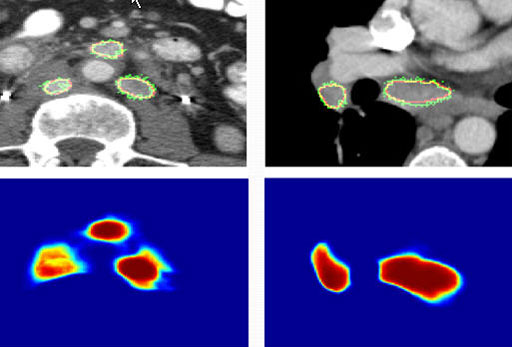Segmentation Makes Lymph-Node Measurement More Accurate
By MedImaging International staff writers
Posted on 15 Dec 2016
Neural networks could help a new automated lymph-node segmentation method improve cancer care, according to a new study.Posted on 15 Dec 2016
Developed at the U.S. National Institutes of Health (NIH, Bethesda, MD, USA), the new analysis method combines two holistically nested neural networks (HNNs) and structured optimization techniques in order to solve the problem of separating lymph nodes from similar surrounding tissues on radiographic images. In addition, the technique can measure the volume of the lymph node clusters, which is a more accurate estimation of size than diameter.

Image: Lymph nodes segmented by BNF (green), with corresponding BNF probability maps (Photo courtesy of Ronald Summers/NIH).
The two HNNs, built on convolutional and deeply supervised neural networks, are trained to learn lymph-node cluster appearance (HNN-A) or contour (HNN-C) probabilistic output maps derived from thoracoabdominal computerized tomography (CT) images. The two components are prominent in the concept of boundary neural fields (BNF), which matches lesion measurements with more than 80% accuracy. To do so, HNN-A and HNN-C predictions are formulated into unary and pairwise terms of conditional random fields (CRFs).
The CRFs are subsequently solved using three standardized output methods: dense CRF (dCRF), graph cuts (GC), and BNFs. All of these segmentation predictions are used to compute lymph-node cluster volumes on the dataset. An expert radiologist then segments all enlarged lymph nodes with short-axis diameters of at least 10 mm. According to the researchers, the method could significantly improve cancer care by making lymph-node measurements more accurate. The new segmentation method was presented at the RSNA annual conference, held during November 2016 in Chicago (IL, USA).
“Thoracoabdominal lesions are among the most challenging to analyze on CT. The reason for this is that CT images of this region display very poor intensity and texture contrast. This is due to the fact that lymph nodes are very similar in intensity to many of the surrounding tissues,” said lead author and study presenter Isabella Nogues, MD. “Also, the high frequency of lymph-node clusters and the ambiguous boundaries of lymph nodes make accurate measurement very difficult.”
“The main conclusion was that boundary neural field was the most accurate segmentation method, which is very promising for the development of imaging biomarkers based on volume measurements,” concluded Dr. Nogues and colleagues of the NIH Imaging Biomarkers and Computer-Aided Diagnosis Laboratory. “These volume measurements, in turn, could potentially improve response evaluation criteria in solid tumors (RECIST) measurements for lymph nodes.”
Related Links:
U.S. National Institutes of Health














